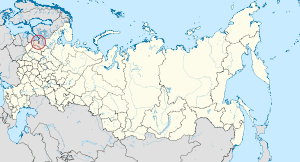St. Peterburg
|
Saint Petersburg Санкт-Петербург (Russian) |
|||||
|---|---|---|---|---|---|
| — Federal city — | |||||
|
Clockwise from top left: Peter and Paul Fortress on Zayachy Island, Smolny Cathedral, Bronze Horseman on Senate Square, the Winter Palace, Trinity Cathedral, and the Moyka river with the General Staff Building. |
|||||
|
|||||
|
|||||
|
|
|||||
| Political status | |||||
| Country | Russia | ||||
| Federal district | Northwestern | ||||
| Economic region | Northwestern | ||||
| Established | 27 May 1703 | ||||
| Federal city Day | 27 May | ||||
| Government (as of March 2010) | |||||
| • Governor | Georgy Poltavchenko (UR) | ||||
| • Legislature | Legislative Assembly | ||||
| Statistics | |||||
| Area | |||||
| • Total | 1,439 km2 (556 sq mi) | ||||
| Area rank | 82nd | ||||
| Population (2017 est.) | |||||
| • Total | 5,323,300 (permanent residents within city limits) | ||||
| Time zone(s) | MSK (UTC+03:00) | ||||
| ISO 3166-2 | RU-SPE | ||||
| License plates | 78, 98, 178 | ||||
| Official languages | Russian | ||||
| Official website | |||||
Saint Petersburg (Russian: Санкт-Петербу́рг, tr. Sankt-Peterburg, IPA: [ˈsankt pʲɪtʲɪrˈburk] (![]() listen)) is Russia's second-largest city after Moscow, with five million inhabitants in 2012. An important Russian port on the Baltic Sea, it has a status of a federal subject (a federal city).
listen)) is Russia's second-largest city after Moscow, with five million inhabitants in 2012. An important Russian port on the Baltic Sea, it has a status of a federal subject (a federal city).
Situated on the Neva River, at the head of the Gulf of Finland on the Baltic Sea, it was founded by Tsar Peter the Great on May 27 [O.S. 16] 1703. In 1914, the name was changed from Saint Petersburg to Petrograd (Russian: Петрогра́д, IPA: [pʲɪtrɐˈgrat]), in 1924 to Leningrad (Russian: Ленингра́д, IPA: [lʲɪnʲɪnˈgrat]), and in 1991 back to Saint Petersburg. Between 1713 and 1728 and in 1732–1918, Saint Petersburg was the capital of imperial Russia. In 1918, the central government bodies moved to Moscow.
...
Wikipedia




